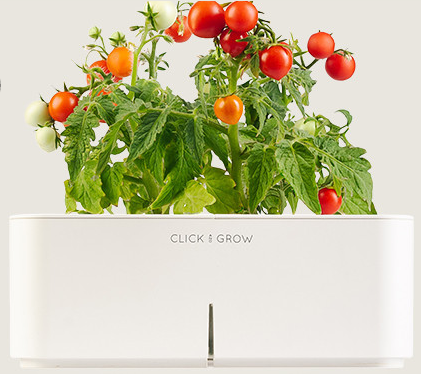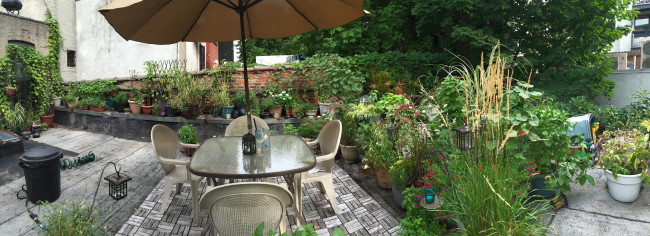Growing a lawn from seed in New York City: One resident's attempt
Can this barren patch be greened? Let's find out!
New Yorkers are a funny bunch. Most of us have forsaken our place of origin in favor of the unique, sometimes maddening, occasionally wonderful experience that is living in New York City. And then we try to recreate aspects of the very place we left behind. One example is my attempt at a garden oasis on a roof deck.
Another case in point: trying to grow a lawn.
Obviously, it's a small percentage of New Yorkers who have any square footage of soil in which to grow grass, but they do exist, particularly in the outer boroughs. (Although plenty of Manhattanites give it a whirl, too—and as a result of the sheer density of buildings, have the least success.)
This spring, I became one of those New Yorkers. While I don't have a rolling expanse of land to seed, there is a relatively small yard area in front of my house. Last fall we removed some strangely-placed shrubs from the area, as well as a light-blocking hedge wall. This resulted in the open space my husband and I agreed would look best filled with grass. A neglected lawn of spotty quality had surrounded the plants previously, so it seemed possible, that with some care, we could make one happen.
I accepted the challenge and dug in.
Here's the story of my attempt to grow a (small) lawn from grass seed in Brooklyn. My effort was informed by some online research, pulling from both manufacturer's web sites (big names in the grass and lawn game like Scott's and Pennington) and assorted blogs and forums, where people freak out and ask lots of questions about growing grass.
With the seed in the ground for over a week, I fact-checked my process with Daniel Hunter, president of Trillium Landscape Design, to find out if my sources had served me well. I also scoured other tips for New Yorkers wanting to grow their own slice of the suburbs.
When to do it
Anyone who knows anything about growing grass from seed will tell you the best time to do it is in the fall. (This was, of course, one of the first things Hunter said to me.)
I knew this from my research. I bought the seed in the autumn. Things got away from me. Cut to—springtime.
Assessing the conditions above and around
"The big thing to know is if you have enough sun," says Hunter. The ideal light condition for growing a lawn is full sun, which in plant speak is at least six hours a day, but for a lawn, probably more like seven or eight. Your light conditions will dictate the kind of seed you plant. Full-sun seed mixes will have a combination of perennial ryegrass, Kentucky bluegrass, and fescue, while part-shade mixes will contain various kinds of fescue.
If your proposed lawn area is mostly in shade? Hunter says a lawn isn't for you. (That's what he tells his clients; it's just not going to work.)
In addition to light, your seed and lawn will need air circulation. Without it, the grass is susceptible to mold and disease. This is why Manhattan, with its tall buildings and enclosed spaces, is a particularly challenging environment for growing grass.
The area I'm dealing with gets a fair amount of sun, especially since we took out the hedge, which blocked light to at least part of the yard. But it's not baking all day, and I wasn't feeling super confident, so I bought some Scott's Sun & Shade Mix, which claimed to grow in "extreme" conditions like full sun and dense shade. (I realized that was probably an overpromise, but figured if I had something in between it would work well enough.) And while I hadn't considered air circulation, I think I'm ok in that department.
Assessing conditions below
I know from my experience as a gardener that if you don't start with good soil, you can't expect good results. And, that "good soil" means both nutrients in the form of organic matter, as well as proper drainage. (If your soil doesn't drain well, roots can't breathe, plants die.) I considered using those spiky, Birkenstock-esque "sandals" to try to aerate the soil (in terms of compaction it wasn't the worst, but I knew it could use some loosening up), but online reviews indicated they weren't all they were cracked up to be. I ended up doing it the old-fashioned way: taking a shovel and turning the soil. It was a small enough area that I was able to do it without too much trouble.
Hunter says that's fine, or you can use a tiller on the lowest setting. (Turning the top two to three inches is fine, although the deeper you till the better drainage you'll achieve.)
I didn't go crazy amending the soil, but did buy a couple of bags of topsoil and raked them in. (I thought about compost or manure, but that seemed messy and potentially smelly so I skipped it.) Again, Hunter says amending the soil with organic matter is always nice, but that grass seed doesn't need a perfectly-prepared substrate to grow. "Seed's are not fussy. As long as you give them something fresh to grow in," he says.
What is important, is soil-to-seed contact. To spread the seed (I used a seed spreader the previous owner had left behind), drag a rake over the soil to mix in the seed, and then gently press it down in place. (Ideally, you'd roll it out with a lawn roller, but those are kind of pricey and are overkill for a small area.) The point is you want to compact it a little.
Extra starter help
I had this vague notion that I needed to put down straw but wasn't sure why. After a little thought, it made sense: to keep in moisture to aid in germination; to keep the seeds from blowing away, and to prevent birds from eating all the seeds.
Surprise: Home Depot doesn't sell straw. They do, however, sell this Netless Seed Mat, which I bought on a whim for $20. Pennington claims it does the same thing as hay, and also biodegrades. (It's also good for planting on slopes apparently.)
Hunter is familiar with the practice of using hay. He's never done it. (While he has many years of experience doing this for clients, he also clearly feels that grass seed and lawns aren't as fragile as some might lead you to believe.)
I put the mat on and I watered well.
Waiting and watering
Hunter's more seasoned and relaxed stance aside, keeping the seeds moist in those first few days is key to germination. (One thought from a grass guru I found online was "a dry seed is a dead seed." It made an impression.) So it's important to prevent things from drying out completely, but note that pooling water is a sign of poor drainage and should be addressed.
As mentioned, seed mixes contain different varieties of seeds, which will have different germination rates; some seeds germinate in as little as five days, while others can take as long as 30. It's important to keep things moist for a while, and equally important to be patient—just because you don't see grass coming up, doesn't mean it won't.
Over the course of about a week-and-a-half, I watered, benefited from some rainstorms, and sure enough, some wispy, thin blades started poking through my weird, admittedly unattractive seed mat.
There's some growth in the areas outside the seed mat, but it seems pretty clear that it had a positive impact. Birds did, in fact, show up, and I never saw them pecking around on the mat—just the area left "unprotected." (It felt like a losing battle to shoo them away, as they would just return to the easy buffet.)
The really good news: it's not a one-shot, do-or-die situation, which some online resources would have you believe. When I asked Hunter if it was okay to go back and seed some barren patches he said, "Oh yeah. I do that all the time."
The truth is, you can plant grass seed any time, it's just dumb and expensive to plant it in the heat of summer because it dries out so fast. If you're still in temperate spring (or fall) weather, a do-over, or improvement seeding is fair game—just refer back to rule #1 of keeping it moist.
Cultivating and maintaining
My "lawn" is still coming in. It definitely shows signs of life, but I'm hoping it becomes more robust, with additional seeds germinating and additional warm weather growth.
When asked about nurturing this early growth with consistent watering, Hunter was again a bit more relaxed about moisture levels, saying that a quick spray or mist over seedlings and new growth can keep things viable and that even dew can do the job. He even went so far as to say that a short dry period can be beneficial for grass growth.
Hunter says fertilizing is key, but that there's no need to go overboard. "Some people fertilize four to five times a year. That's way too much," he says. (In fact, in New York State it's against the law to fertilize before April first, in an effort to prevent chemical runoff into the watershed.)
Hunter recommends fertilizing in early spring with a fertilizer with a high phosphorous content to promote root growth; using a fertilizer with high nitrogen content for vegetative growth in June or July, and feeding as the season ends with a fertilizer with low nitrogen. You can find granular fertilizer products at home improvement stores and garden centers which will be labeled with levels of the three main components of fertilizers; nitrogen, phosphorous, and potassium.
Good luck! Here's hoping both of us get to proudly yell, "Get off my lawn!"

























